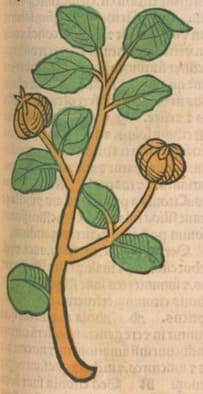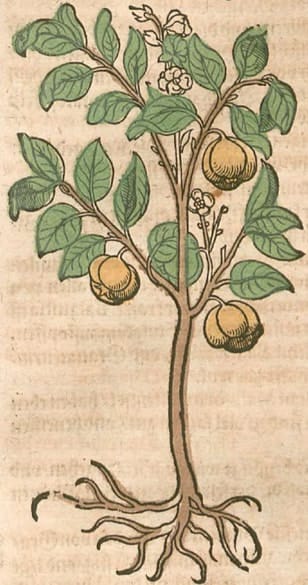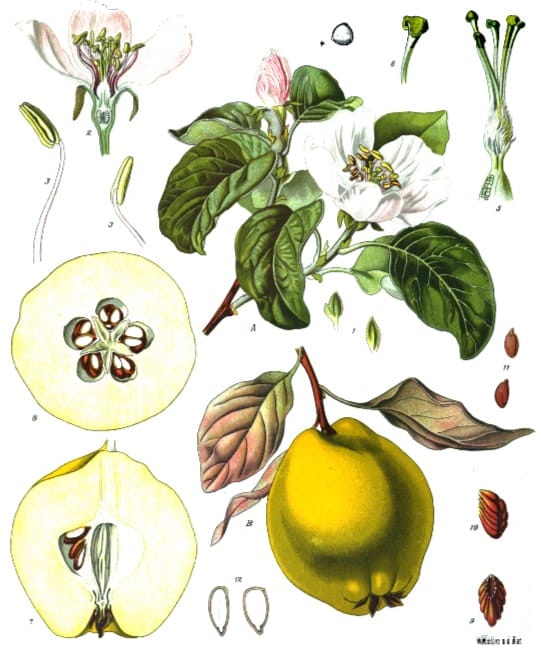Cydonia malus, Quince
Behi, Behidana, Safarjal (Unani)Safar Jal, Bizr Safarjal (Arabic)
 Ortus Sanitatis, Meydenbach, 1491
Ortus Sanitatis, Meydenbach, 1491

|

|
|
Della Materia Medicinale, Andrea Valuassori, 1562 |
Krauterbuch, Lonitzer, 1578 |
 Koehler’s Medizinal Pflanzen, 1887
Koehler’s Medizinal Pflanzen, 1887Botanical name:
Cydonia oblonga, C. vulgaris
Parts used:
Fruit (fresh or dried); Seed
Temperature & Taste:
FRUIT: Cool, dry. Sour; astringes, nourishes. Sweet Quince is less astringent.
SEED: Cool, moist. Sweet; lenifies, abates sharpness
“Quince is Cold in the last phase of the First and Dry in the beginning of the Second degree”. (Avicenna)
Classifications:
B. Clear Heat
Uses:
FRUIT:
1. Benefits the Stomach, Clears Heat:
-Fluxes and looseness of the Stomach (from Heat)
-stops ‘Vapors’ rising to the Head from the Stomach
–With vinegar for poor appetite and to promote Appetite and stop Vomiting
-With spices it strengthens the Stomach and Liver
-Conserve of Quince was a routine first-line-of-treatment for Epidemic Diarrhea, especially in children, the old, and the weak
-The Syrup with Spices was regarded as very good to strengthen both mother and child during Pregnancy.
2. Clears Heat, Resists Poison:
-juice of ripe Quinces taken alone was long held a ‘preservative against the force of Deadly poison; for it hath been found most certain true, that the very smell of a Quince hath taken away all the strength of the Poison of White Hellebore.’ (Culpeper)
-“Its syrup, infusion and decoction are taken as a dessert after the intake of wine to prevent Hangover”. (Avicenna)
3. Benefits the Heart:
‘They cheer people up and stimulate them’. (Tacuinum Sanitatus)
4. Externally:
-‘The Cotton or Down of Quinces boyled and applied to Plague Sores, heals them up’. (Culpeper)
-The same cotton ‘laid as a Plaster made up with Wax, it brings hair to them that are bald, and keeps it from falling if it be ready to shed’. (Culpeper)
SEED:
1. Clears Heat, Nourishes the Yin:
-heat and sharpness of the Lungs, Stomach, Bladder, Kidneys or Bowels
-Seeds were used for their cooling, soothing mucilage in compounds for the Lungs etc.
-dryness or itchiness of the Throat, Heat-type Cough, Bronchitis, Tuberculosis.
2. Clears Heat, Resists Poison:
-Catarrh, Gonorrhea, Dysentery
-Fever, heat and inflammation.
-Mucilage was used for dryness of the mouth and thirst associated with Fever.
3. Externally:
-the seeds are used in poultices for Injuries, Joint Inflammations
-a lotion of the seeds soothes sore, red Eyes.
-the mucilage is used externally for Burns, Scalds and Blisters.
-mucilage was also applied to heat and inflammation of the Eyes.
-Allays the pain of Hemorrhoids, used in an enema
-Mucilage is applied to clefts in the Breasts, Chapped Nipples; Burns; Injuries; Inflammations
-Used for swellings of the Tongue (as a gargle)
-“Its oil is also useful in Herpes“. (Avicenna)
Comment:
The Syrup, Rob (concentrated juice), or mucilage of the Seeds were all commonly used as binders in making Pills and Troches.
Dose:
1. Taken before food the fruit Binds, after food, it loosens (is laxative).
2. The Unripe fruit is more binding and less strengthening.
Seed in decoction: 3–6 grams;
Seed in Powder: 1–3 grams
Correctives:
1. Sugar;
2. Fennel seeds
Substitutes:
Ispaghol seed for Quince seed

Main Combinations:
1. To strengthen the Stomach and Spleen, benefit Digestion, Diarrhea etc., the Juice is made into a Syrup with Cinnamon, Cardamon, Clove, Ginger and Saffron (as in Syrup of Quince with Spices, or Aromatic Syrup of Quince)
2. Vomiting, Diacytonium Simplex after eating (Herbarium Horstianum, 1630)
3. Diarrhea, Unripe Quince is made into an Electuary to which Rose and torrefied Rhubarb are added.
4. Dysentery:
i. add Rhubarb and Chebulic Myrobalan to Syrup of Quince.
ii. Syrup of Quince (Diacytonium) with Tormentil and Sorrel (Herbarium Horstianum, 1630)
5. Dysentery, Leukorrhea:
i. Quince Wine (Herbarium Horstianum, 1630)
ii. Quince flower, Pomegranate flower, Rose flower, mixed with Gum Arabic to form a plaster to apply to the umbilicus (Herbarium Horstianum, 1630)
6. Diuretic: ‘The decocted Quince with honey is very diuretic’. (Avicenna)
7. Infertility from Damp, Syrup of Quince (Diacytonium) (Herbarium Horstianum, 1630)
Major Formulas
Syrup of Quince with Spices
Electuary of Quince with Spices
Electuary of Quince Compound
Decoction Against Vomiting
Decoction of Hyssop (Zacharia)
Syrup of Jujube Compound (Mesue)
Syrup of Psyllium (Mesue)
Syrup of Violet (De morbus internis curandis)
Syrup of Violet Compound
Water for Cancer
Powder for Dry Cough
Troches of Gordon (Trochisci Gordonii)
Pills to Hold in the Mouth for Catarrh
Cautions:
Generally Safe. Quince may aggravate Colic if not corrected.
Avicenna said ‘The excessive use of quince produces neuralgia’.
Main Preparations used:
Candied Quinces, Wine of Quinces, Rob of Quinces, Marmalade, Syrup of the Juice both Simple and Aromatized, Diacydonium Simple and Compound, Laxative Diacydonium, Spirit of the fermented Juice, and an Oil by Infusion.
1. Roasted Quince:
‘The roasted quince is lighter and more useful. The method of its roasting comprises of scooping out the seeds, filling the cavity with honey, covering the whole quince with clay and placing it on hot ashes’. (Avicenna)
2. Rob or Jelly of Quinces:
i. Quince, cored with seeds removed (2 parts), boil in sufficient water, strain through a sieve, then with White Sugar (3 parts), boil gently to the desired consistency. (Pharmacopoeia Sardoa, 1773)
ii. Depurated Juice of Quince (6 parts), White Sugar (1 part). Boil to the consistency of Honey. (Dispensatorium Fuldense, 1791)
3. Syrup of Quince:
i. Juice of Quince (2 parts) White Sugar (3 ½ parts), melt the sugar in the juice with a moderate heat as soon as it is expressed. (Pharmacopee Usuelle, Louvain, 1821)
4. Mucilage of Quince seed:
i. Quince seed (2 drams), Water, sufficient. Boil slowly to the consistency of a mucilage, then strain.
5. Aromatic Jelly of Quince (Quince Syrup with Spices):
i. Jelly of Quinces (any quantity), suspend in a bag containing powders of Cinnamon, Lesser Cardamon (1 ½ drams), Saffron, Clove, Ginger, Mastic, Mace (1 scruple each). Macerate and keep. (Pharmacopoeia Generalis, 1783)
ii. Jelly of Quinces (1 lb.), Powders of Cinnamon (2 drams), Ginger (1 dram), Clove (2 scruples), Galangal, Mace, Nutmeg (½ dram). Mix. (Dispensatorium medico pharmaceuticum Palatinatus, 1764)
